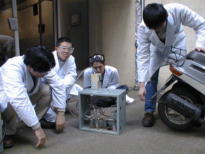Students experiments
Practical Applied Chemistry I
Study is divided into a beginner's course, a fundamentals course and an applied chemistry course. In the beginner's course, students study points to be noted in experiments by watching videos of experiments and do glasswork.

Glasswork is the basic skill of experimentation.
The fundamentals course and the applied chemistry course are divided into three sub-courses: physical chemistry, organic chemistry, and inorganic and analytical chemistry. In physical chemistry, students measure surface tension, densities and mutual solubilities of liquids. Students carry out organic qualitative analysis (ignition test, detection of halogen using Beilstein's test, detection of halogen and nitrogen using Lassaigne's test) in organic chemistry. In inorganic and analytical chemistry, students carry out qualitative analysis of positive ions.
Practical Applied Chemistry II
Physical chemistry
1. Vapor pressure of liquid
2. Heat of reaction
3. Electrode potential
4. Electrolysis
5. Oxidation-reduction potential
6. Surface area of solids
7. Electronic absorption spectra of charge-transfer complexes
8. Gas chromatography
9. Electric circuit
10. Flow inside packed bed
11. Heat exchanger
12. Absorption spectroscopy of mixed solutions of Co2+ and Ni2+
Organic chemistry
1. Preparation of N-acetylglycine
2. Preparation of 2-methyl-4-benzylidene-5-oxazolone
3. Preparation of ethyl (-acetoaminocinnamate
4. Acetylation of α-D-glucose with pyridine catalyst;α-D-glucopyranose pentaacetate
5. Acetylation of 2-amino-2-deoxy-α-D-glucose with zinc chloride catalyst; 2-acetamido-tetra-O-acetyl-2-deoxy-β-glucopyranose
6. Preparation of ethyl 4-bromocrotonate
7. Polyvinyl acetate (Suspension polymerization)
8. Polyvinyl alcohol
9. Preparation of polyvinyl cinnamate and photochemical reaction
10. Separation of caffeine
11.Preparation of ethyl acetoacetate
12. Preparation of phenethyl bromide
13. Preparation of styrene from phenethyl bromide
14. Preparation of adipic acid
Inorganic and analytical chemistry
1. Separation of Fe(III), Co(II), Ni(II) using anion exchange resins
2. Quantitative determination of Na and Ca in artificial seawater using frame photometry
3. Measurement of NOx
4. Decomposition of silicates using alkali fusion and quantitative determination of copper using extraction photometry
Determination of the component ratios of complexes -- Continuous Variation Method --
Electronic absorption and infrared spectra of metal complexes.
Solid phase reactions


